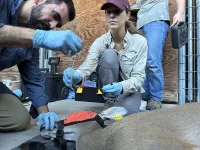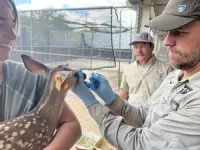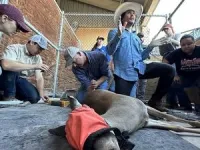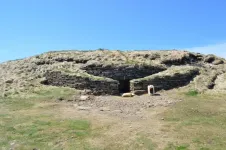(Press-News.org) Texas A&M University scientists and research partners have received two National Institute of Food and Agriculture (NIFA) Agriculture and Food Research Initiative (AFRI) grants to study the spread of SARS-CoV-2 in deer. These funds will help researchers understand the impact of the virus in Texas’ deer populations and its relationship to human and ecological health.
For these projects, the research team will focus on captive deer, which are an agricultural species in Texas, including managed deer that live on large, rural properties enclosed by fences, as well as on the wild deer with which captive deer may interact and deer living in zoos and wildlife centers.
Understanding The Ecology Of Disease
The first $800,000 USDA grant will fund a multifaceted three-year project designed to help scientists understand how the virus that causes COVID-19 spreads among deer and, for the first time, how the SARS-CoV-2 virus has impacted overall deer health.
What makes the study unique is its focus on understanding disease in the context of whole ecological systems, examining not only how captive deer interact with each other, but also how the diverse wild and captive animal community may interact with the deer. For example, the study will investigate patterns of infection among captive deer, the humans who work with the deer, other domestic livestock on the ranches, as well as wild mammals in the environment.
To do this, researchers at Texas A&M will collaborate with the Deer Research Program at the Texas A&M University-Kingsville’s (TAMUK) Caesar Kleberg Wildlife Research Institute, which will help collect the large number of samples needed for the project.
“The first aim of the project is a screening study (testing the deer for SARS-CoV-2) of 30 ranches, farms, or other managed areas with deer across the state, such as safari-style parks and zoos,” said Dr. Sarah Hamer, professor of epidemiology at the Texas A&M School of Veterinary Medicine & Biomedical Sciences (VMBS) and lead researcher for Texas A&M on both projects. “This stage will allow us to see where there has been deer exposure to the virus in the past and where there are active infections.”
The second stage of the project will focus on locations where coronavirus infections are found in deer.
“If we find infected deer, we will then transition to a phase of the study where we can not only re-sample the deer over time to monitor changes in their infection and health, but also sample other farm animals and native wildlife on each property. We will also sample the people on each ranch who regularly interact with the deer,” Hamer explained. “These will most likely be the workers who are responsible for putting out the feed and water for the animals.”
This broader range of samples will help Hamer and the rest of the team learn more about the transmission of the SARS-CoV-2 virus between animals and people that share an ecological relationship. Their approach to consider humans, animals, and the environment was proposed after Hamer’s teams spent more than two years studying the virus among people and their pet dogs and cats in Centers for Disease Control and Prevention-funded research; that research showed that infections were not uncommon among domestic animals that live in houses with active human cases.
The laboratory analyses for the deer project will be overseen by Dr. Gabriel Hamer, professor in the Texas A&M Department of Entomology.
“Once we detect positive samples for SARS-CoV-2, we will work with partners to sequence the viral genomes across all of the infected species and see how they compare,” he said. “We want to see if we can infer which direction the infection is spreading among deer, other animals, and humans.”
The final part of the three-year project will analyze how overall deer health has been impacted by the virus.
“Of all four goals, this one is probably the most important for the deer producers,” said Dr. Walt Cook, a clinical associate professor in the VMBS’ Department of Veterinary Pathobiology and co-investigator on the project. “We want to know if SARS-CoV-2 might affect things like body condition, antler growth, and reproduction.”
The robust captive cervid industry in Texas makes this an ideal state for better understanding how and when the virus infects deer. In comparison to tracking wild deer, the opportunity to study deer belonging to managed herds will allow researchers to answer many of the unknown questions about SARS-CoV-2 and deer health.
“Most of the existing studies on wild deer rely on hunter-harvested samples,” Sarah Hamer said. “A deer may test positive for a SARS-CoV-2 infection, but at that point, the body has been processed and we can’t know its symptoms or if the virus impacted the deer’s health or fitness in any way.”
“We’re extremely appreciative that producers across the state are allowing us to study their herds so that we can better understand how SARS-CoV-2 is maintained in nature,” Cook said. “We have the opportunity to study the ecology of the disease in real settings across the state to learn about what these animals may be exposed to, while maintaining anonymity (with no information regarding specific test results, locations of properties, or premise ownership being released publicly or to any agency), to benefit us all in the future.”
Because of the project’s unique scope and complexity, the researchers hope to answer questions relating SARS-CoV-2 to many different aspects of human, animal, and environmental health.
“For the last three years, zoonotic disease has brought the world to a halt and impacted virtually every aspect of life on earth,” said Dr. Michael Cherry, a white-tailed deer expert at TAMUK and partner on the projects. “Understanding the ecology of these diseases and how they affect human health, food security, and important sectors of the economy will make us better prepared for future zoonotic outbreaks.”
“The diverse team is one of the unique aspects of this ambitious project,” Cherry said. “Dr. Hamer has pulled together a fantastic team, and I’m happy to be able to contribute.”
Protecting Against Future Outbreaks
The second project, funded by a $650,000 USDA grant and spearheaded by biotech company Ginkgo Bioworks, will include sequencing the RNA of SARS-CoV-2 found in white-tailed deer to better understand which strains are active in deer populations and to track possible mutations so that we can better protect ourselves from future outbreaks of the virus in the human population.
“Zoonotic research like this is key to helping make informed decisions and avoid future outbreaks,” said Matt McKnight, general manager of biosecurity at Ginkgo Bioworks. “This data and research will provide governments, industry leaders, and academics the information they need to optimize behaviors and provide early warnings to prevent disease spillover.”
The first part of the project entails sampling and testing deer to see if they carry SARS-CoV-2. Once the researchers have the positive samples, they can begin sequencing genomes from the virus samples.
“Our group at Texas A&M will be responsible for working with collaborators to collect samples from deer,” Hamer said. “We’ll also be responsible for the initial screening for SARS-CoV-2. If we find positive samples, we ship them to Ginkgo and they’ll work to sequence the virus and analyze how the sequences compare to those found by others.”
In order to reach the sample size goals for the project, the researchers also are collaborating with the Texas A&M Veterinary Medical Diagnostic Laboratory (TVMDL) to gather samples from deer lymph nodes.
“TVMDL regularly gets samples from both wild and captive deer for chronic wasting disease (CWD) testing,” said Carlos Rodriguez, TVMDL epidemiologist. “The samples often come from hunter-harvested deer, and we are able to repurpose the remaining tissue to contribute to this COVID project.”
Because COVID-19 is resurgent in the human population, projects like this one are important given that scientists are still uncovering new ways that the disease continues to impact the world.
“The public health protective measures that are available for humans — like vaccines and masks — really aren’t options for deer,” Hamer said. “We’re interested to learn under what conditions deer become infected and how long they can maintain the infection in nature. Of course, we’re also interested to study potential onward transmission from deer to other deer, wildlife, or humans in order to learn how that may contribute to the overall ecology of this virus in nature.”
By Courtney Price, Texas A&M University School of Veterinary Medicine and Biomedical Sciences
###
END
Texas A&M receives over $1 million in USDA grants to study SARS-CoV-2 in deer
2023-10-17
ELSE PRESS RELEASES FROM THIS DATE:
SwRI develops novel solution to advance synthesis for nerve agent antidotes
2023-10-17
SAN ANTONIO - October 17, 2023 — Southwest Research Institute has developed a unique technology (US20230242487A1) that enables the safe and efficient synthesis of organophosphorus nerve agent (OPNA) oxime antidotes. Using this technology, SwRI scientists can not only successfully synthesize currently known highly effective nerve agent countermeasures, but also effectively develop promising new drug candidates to treat nerve agent exposure.
Current treatments for OPNA exposure have not changed significantly since the 1950s. OPNAs are odorless and colorless chemicals ...
The Foundation for Angelman Syndrome Therapeutics to advance gene therapy candidate through IND-enabling studies conducted in partnership with the University of Pennsylvania
2023-10-17
October 17, 2023—The Foundation for Angelman Syndrome Therapeutics (FAST) announced today that the non-profit organization has entered into an exclusive global collaborative research and development agreement with the University of Pennsylvania to develop an investigational adeno-associated virus (AAV) gene therapy for Angelman syndrome (AS).
Angelman syndrome is a nondegenerative neurogenetic disorder that is estimated to impact approximately 1 in 15,000 births, or potentially 500,000 individuals world-wide, ...
Harnessing molecular power: electricity generation on the nanoscale
2023-10-17
WASHINGTON, Oct. 17, 2023 – Wave energy technology is a proven source of power generation, but there is power inherent in every molecule of liquid on earth, even when the liquid is at rest. At the molecular scale, atoms and ions are always moving. If this nanoscale movement can be harvested, it could be a big source of energy.
“There are vast amounts of air and liquid on the earth, and their successful harvesting could produce a gigantic amount of energy for society,” author Yucheng Luan said.
In an article published this week in APL Materials, by AIP Publishing, Luan and his collaborators tested a molecular energy harvesting device that captures ...
Study reveals our European ancestors ate seaweed and freshwater plants
2023-10-17
For many people seaweed holds a reputation as a superfood, heralded for its health benefits and sustainability, but it appears our European ancestors were ahead of the game and were consuming the nutrient-rich plant for thousands of years.
Researchers say they have found “definitive” archaeological evidence that seaweeds and other local freshwater plants were eaten in the mesolithic, through the Neolithic transition to farming and into the Early Middle Ages, suggesting that these resources, now rarely eaten in Europe, only ...
Effects of the million hearts model on heart attacks, strokes, and Medicare spending
2023-10-17
About The Study: The Million Hearts Model, which encouraged and paid health care organizations to assess and reduce cardiovascular disease (CVD) risk, reduced first-time heart attacks and strokes. The results support guidelines to use risk scores for CVD primary prevention.
Authors: Laura Blue, Ph.D., of Mathematica in Washington, D.C., is the corresponding author.
To access the embargoed study: Visit our For The Media website at this link https://media.jamanetwork.com/
(doi:10.1001/jama.2023.19597)
Editor’s Note: Please see the article for additional ...
Climate network analysis helps pinpoint regions at higher risk of extreme weather
2023-10-17
WASHINGTON, Oct. 17, 2023 – Climate change and the rapid increase in frequency of extreme weather events around the globe – such as wildfires and floods – reinforces the reality that these events are not only not random but, rather, interconnected. Interlinked climate behavior, or teleconnections, isn’t a well understood field but will be necessary to fully comprehend how our climate system works.
In Chaos, from AIP Publishing, a team of researchers affiliated with Beijing Normal University and Beijing University of Posts and Telecommunications in China and the Potsdam Institute for Climate Impact Research in Germany describes a climate network analysis method to explore ...
Race and ethnicity and prehospital use of opioid or ketamine analgesia in acute traumatic injury
2023-10-17
About The Study: The results of this study of over 4.7 million patient encounters across the U.S. during a 3-year period suggest that patients from racial and ethnic minority groups with acute traumatic injuries do not have their pain treated equitably in the prehospital setting.
Authors: Eli Carrillo, M.D., of the Stanford University School of Medicine in Stanford, California, is the corresponding author.
To access the embargoed study: Visit our For The Media website at this link https://media.jamanetwork.com/
(doi: 10.1001/jamanetworkopen.2023.38070)
Editor’s Note: Please see the article for additional ...
Adult attention-deficit/hyperactivity disorder and the risk of dementia
2023-10-17
About The Study: In this study of 109,000 individuals born between 1933 and 1952 and followed up in old age, adult attention-deficit/hyperactivity disorder (ADHD) was associated with an increased risk of dementia. Policy makers, caregivers, patients, and clinicians may wish to monitor reliably for ADHD in old age.
Authors: Stephen Z. Levine, Ph.D., of the University of Haifa in Haifa, Israel, is the corresponding author.
To access the embargoed study: Visit our For The Media website at this link https://media.jamanetwork.com/
(doi: 10.1001/jamanetworkopen.2023.38088)
Editor’s Note: Please see the article for additional information, including ...
AI models identify biodiversity from animal sounds in tropical rainforests
2023-10-17
Tropical forests are among the most important habitats on our planet. They are characterised by extremely high species diversity and play an eminent role in the global carbon cycle and the world climate. However, many tropical forest areas have been deforested and overexploitation continues day by day.
Reforested areas in the tropics are therefore becoming increasingly important for the climate and biodiversity. How well biodiversity develops on such areas can be monitored very well with an automated analysis of animal sounds. This was reported by researchers in the journal Nature Communications.
Recordings on Former Cocoa Plantations and Pastures
As part of the DFG research group ...
Recognizing clinical signs of hyperthyroidism leads to appropriate treatments, reduces adverse impact on health
2023-10-17
(Boston)—Untreated hyperthyroidism, conditions where there is excess thyroid hormone present, can adversely affect health, leading to increased risks for abnormal heart rhythms, heart failure, osteoporosis, adverse pregnancy outcomes, metabolic abnormalities and increased mortality risk. Hyperthyroidism can occur due to several different etiologies, including Graves’ disease, toxic (overactive) thyroid nodules, and thyroiditis. It is important to recognize, correctly diagnose, and appropriately treat the underlying cause of hyperthyroidism to minimize its impacts on health.
In a new review article in the Journal ...






